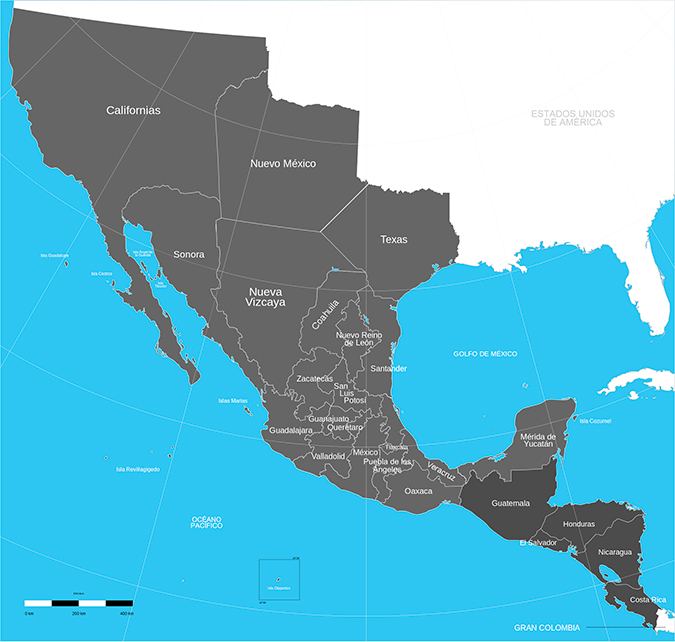
Most countries around the world celebrate an Independence Day, commemorating the date of a country’s statehood. The stories and circumstances of independence vary from peaceful transitions to horrific wars. Mexico is no exception, and the story of Mexico’s flight for independence is complex and intriguing.
The land that is now Mexico, Mesoamerica, has supported the presence of people for thousands of years. Great civilizations have grown, thrived and ended during this time—from Mexico’s oldest known civilization, the Olmecs, to the last great pre-Hispanic civilization, the Aztecs. By 1519, Tenochtitlan, the capital of the Aztec Empire and site of Mexico City, was one of the largest and most grandiose cities in the world with more than 200,000 inhabitants.

Thousands of years of history changed in a single day when on April 22, 1519, Hernan Cortes set foot on the shores of “Mexico” near modern-day Veracruz. This day marks the beginning of the 300 years of Spanish rule in the land that would become Mexico.
Mexico, or New Spain as it was called at the time, became an important jewel in the Spanish crown. During the 16th and 17th centuries, Spain was the leading power in world, elevated to this position through the wealth generated by its American colonies from precious metals, spices, previously unknown produce, textiles and other luxuries.
All of this wealth generated for the crown also created great wealth in New Spain. Yet this new wealth in the colonies was centralized, benefiting only the top of a race-based societal hierarchy called the “casta.” Basically, those born in Spanish with the purest Spanish blood reaped the greatest financial gains while the indigenous, mixed-race and even the Spanish-born in New Spain (criollos) members of society were considered and treated as lower-classes. Over time this attitude did not sit well with these lower classes.

Though uprisings took place over the years, none was successful in overturning the Spanish rule in the new land. Yet the tides started to change with the destabilization of Spanish power in Europe. The growing Age of Enlightenment and Napoleon Bonaparte’s 1808 invasion of Spain opened the doors for new movements of independence in Spanish America, as the second-tier criollos and other lower classes felt discomfort and desired a redistribution of land, justice for the poor and racial equality.
On September 16th, 1810, a criollo priest named Miguel Hidalgo y Costilla, who had been secretly planning a revolt, learned that his plan of revolution had been discovered. Before the Spanish could do anything to stop Hidalgo, he ran to a church in the city of Delores, Guanajuato. Father Hidalgo called on the people to revolt against the Spanish rule by any means. His famous speech, of which the exact words are unknown, became known as the Grito de Dolores (Cry of Delores). This speech inspired the people and began the final revolt against the Spanish rule, and Father Hidalgo came to be recognized as El padre de la Patria (the Father of the Nation).
Hidalgo went on to lead many successful revolts against the Spanish over the following year before being captured and killed in July, 1811 at the age of 58. In Hidalgo’s absence, other leaders stepped up to continue the fight. José María Morelos, also a priest and military general, lead the revolt until his capture and death in December, 1815. From 1815 to 1821, most of the fighting was done by small bands of guerrilla fighters led by Guadalupe Victoria and Vicente Guerrero.
At this time, a colonel in the forces representing Spanish rule, Colonel Agustín de Iturbide, who had fought hard against the independence movement, made a bold move. Unsettled with a military coup back in Spain against the monarchy of Ferdinand VII and changes to Spain’s Constitution following the coup, Iturbide decided to support the revolt and fight for the independence of New Spain, joining forces with Guerrero and rebels across New Spain.
On August 24, 1821 representatives of the Spanish crown recognized the new nation as an independent state by signing the Treaty of Cordoba, coincidentally in Veracruz where Spanish colonization started with the landing of Cortes. On September 27, 1821, Iturbide’s army entered Mexico City; the following day, he claimed independence for the newly formed country and named it the Mexican Empire.

Today, Mexico celebrates its independence on September 16th, the day of the Grito de Delores, even though that day is 11 years before the country gained its independence. Celebrations abound across the country with parades, festivals and a mass gathering in the Zocalo, in central Mexico City, to hear the President perform the Grito Mexicano.
| Spanish | English |
| ¡Mexicanos! ¡Vivan los héroes que nos dieron patria! ¡Viva Hidalgo! ¡Viva Morelos! ¡Viva Josefa Ortiz de Domínguez! ¡Viva Allende! ¡Viva Aldama y Matamoros! ¡Viva la Independencia Nacional! ¡Viva México! ¡Viva México! ¡Viva México! |
Mexicans! Long live the heroes who gave us our homeland! Long live Hidalgo! Long live Morelos! Long live Josefa Ortiz de Domínguez! Long live Allende! Long live Aldama and Matamoros! Long live the nation’s independence! Long Live Mexico! Long Live Mexico! Long Live Mexico! |
This is an incredible time to experience Mexico and its celebrations. If you are intrigued, contact Journey Mexico and let us put together a custom trip for you to experience this proud celebration in Mexico.
The post Celebrate “El Grito”: Mexico Independence Day appeared first on Journey Mexico.

EmoticonEmoticon